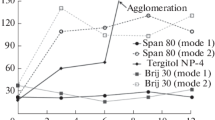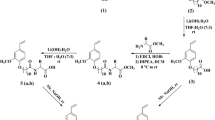Abstract
Solubilization of water and aqueous NaCl in mixed reverse micelles (RMs) comprising sodium bis(2-ethylhexyl) sulfosuccinate (AOT), and polyoxyethylene (20) sorbitan trioleate or polyoxyethylene (20) sorbitan monooleate has been studied at different compositions (X nonionic = 0–1.0) at a total surfactant concentration, S T = 0.10 × 103 mol m−3 in biocompatible oils of different chemical structures; viz., ethyl oleate (EO), isopropyl myristate (IPM) and isopropyl palmitate (IPP) at 303 K. The enhancement in water solubilization (i.e., synergism) has been evidenced by the addition of nonionic surfactant to dioctyl sulfosuccinate/oil(s)/water systems. Addition of NaCl in these systems at different X nonionic enhances their solubilization capacities further until a maximum, ω NaCl,max is reached. ω NaCl,max and [NaCl]max (concentration at which maximization of NaCl solubilization occurs) depend on type of nonionic surfactant, its content (Xnonionic) and oil. A new solubilization efficiency parameter (SP*water or SP*NaCl) has been proposed to compare solubilization phenomena in these oils. The energetic parameters of the desolubilization process of water or aqueous NaCl in single and mixed RMs have been estimated. Energetically, the water dissolution process in oil has been found to be more exothermic as well as more organized in IPP. Overall, the dissolution of water and aqueous NaCl in mixed RMs is entropically driven process. Conductance behavior of these systems in the presence of NaCl has been investigated under different [NaCl] at 303 K. An attempt has been made to give an insight to the mechanism of solubilization phenomena, percolation in conductance and microstructures vis-à-vis role of biocompatible oils in these systems.









Similar content being viewed by others
References
Paul BK, Moulik SP (2001) Uses and applications of microemulsions. Curr Sci 80:990–1001
Garti N, Aserin A (2006) Microemulsions for solubilization and delivery of nutraceuticals and drugs. In: Benita S (ed) Microencapsulation methods and industrial applications. Taylor & Francis, New York, pp 345–428
Bagwe RP, Kanicky JR, Palla BJ, Patanjali PK, Shah DO (2001) Improved drug delivery using microemulsions: rationale, recent progress, and new horizons. Crit Rev Ther Drug Carr Syst 18:77–142
Tenjarala S (1999) Microemulsions: an overview and pharmaceutical applications. Crit Rev Ther Drug Carr Syst 16:461–524
Fanun M (2011) Biocompatible microemulsions. In: Fanun M (ed) Colloids in biotechnology. CRC, New York, pp 417–436
Liu DJ, Ma JM, Cheng HM, Zhao ZG (1998) Solubilization behavior of mixed reverse micelles: effect of surfactant component, electrolyte concentration and solvent. Colloids Surf A 143:59–68
Li Q, Li T, Wu J (2002) Water solubilization capacity and conductance behaviors of AOT and NaDEHP systems in the presence of additives. Colloids Surf A 197:101–109
Paul BK, Mitra RK (2005) Water solubilization capacity of mixed reverse micelles: effect of surfactant component, the nature of the oil, and electrolyte concentration. J Colloid Interface Sci 288:261–279
Liu D, Ma J, Cheng H, Zhao Z (1998) Solubilization in mixed reverse micellar systems of AOT/nonionic surfactants/n-heptane. J Disp Sci Technol 19:599–611
Liu D, Ma J, Cheng H, Zhao Z (1998) Fluorescence probing of mixed reverse micelles formed with AOT and nonionic surfactants in n-heptane. Colloids Surf A 139:21–26
Fersht AR, Freeman WH (1985) Enzyme structure and mechanism, New York
Kon-No K, Kitahara A (1972) Secondary solubilization of electrolytes by di-(2-ethylhexyl) sodium sulfosuccinate in cyclohexane solutions. J Colloid Interface Sci 41:47–51
Kon-No K, Kitahara A (1970) Solubilization of water and secondary solubilization of electrolytes by oil-soluble surfactant solutions in nonaqueous media: I. Dodecylammonium carboxylates. J Colloid Interface Sci 33:124–132
Kon-No K, Kitahara A (1970) Solubilization of water and secondary solubilization of electrolytes by oil-soluble surfactant solutions in nonaqueous media: II. Polyoxyethylene nonylphenyl ethers. J Colloid Interface Sci 34:221–227
Mitra RK, Paul BK (2005) Effect of NaCl and temperature on the water solubilization behavior of AOT/nonionics mixed reverse micellar systems stabilized in IPM Oil. Colloids Surf A 255:165–180
Gu G, Wang W, Yan H (1994) Calorimetric investigation of the solubilization of water-in-sodium dodecylbenzenesulfonate reversed micelles and water-in-oil microemulsions in mixed solvent of n-heptane and n-pentanol. J Colloid Interface Sci 167:87–93
Ray S, Moulik SP (1995) Phase behavior, transport properties, and thermodynamics of water/AOT/alkanol microemulsion systems. J Colloid Interface Sci 173:28–33
Mukhopadhyay L, Mitra N, Bhattacharya PK, Moulik SP (1997) Thermodynamics of formation of biological microemulsion (with cinnamic alcohol, aerosol OT, Tween 20, and water) and kinetics of alkaline fading of crystal violet in them. J Colloid Interface Sci 186:1–8
Mukherjee K, Mukherjee DC, Moulik SP (1997) Thermodynamics of microemulsion formation. J Colloid Interface Sci 187:327–333
Moulik SP, Das ML, Bhattacharya PK, Das AR (1992) Thermodynamics of microemulsion formation. 1. Enthalpy of solution of water in binary (Triton X 100 + Butanol) and ternary (Heptane + Triton X 100 + Butanol) mixtures and heat capacity of the resulting systems. Langmuir 8:2135–2139
Ray S, Bisal SR, Moulik SP (1994) Thermodynamics of microemulsion formation. 2. Enthalpy of solution of water in binary mixtures of aerosol OT and heptane and heat capacity of the resulting systems. Langmuir 10:2507–2510
Hill RM (1993) Applications of surfactant mixtures. In: Ogino K, Abe M (eds) Mixed surfactant systems, surfactant science series 46. Dekker, New York, pp 317–336
Grabner D, Matsuo T, Hoinkis E, Thunig C, Hoffmann H (2001) Sodium and calcium laurylamidomethylsulfate: aqueous micellar phases, their properties, and a precipitate of vesicles. J Colloid Interface Sci 236:1–13
Lee DH, Chang HW, Cody RD (2004) Synergism effect of mixed surfactant solutions in remediation of soil contaminated with PCE. Geosci J 8:319–323
Kundu K, Paul BK (2013) Physicochemical investigation of mixed surfactant reverse micelles: I. water solubilization and conductometric studies (communicated)
Li Q, Li T, Wu JG (2001) Electrical conductivity of water/sodium bis(2-ethylhexyl) sulfosuccinate/n-heptane and water/sodium bis(2-ethylhexyl) phosphate/n-heptane systems: the influences of water content, bis(2-ethylhexyl) phosphoric acid, and temperature. J Colloid Interface Sci 239:522–527
Mitra RK, Paul BK (2005) Investigation on percolation in conductance of mixed reverse micelles. Colloids Surf A 252:243–259
Paul BK, Mitra RK (2006) Conductivity of reverse micellar systems of Water/AOT + Brij-56 or Brij-58/IPM and their percolation under varied concentrations of amphiphiles and different additives. Colloids Surf A 273:129–140
Das ML, Bhattacharya PK, Moulik SP (1990) Reaction kinetics in microemulsion medium. 1. Inversion of cane sugar in quaternary system of microemulsion containing water/triton X-100/1-butanol/(cholesteryl benzoate + n-Heptane). Langmuir 6:1591–1595
Ruckenstein E, Karpe P (1991) Enzymatic super- and sub activity in nonionic reverse micelles. J Phys Chem 95:4869–4882
Fanun M (2009) Microemulsions formation on water/nonionic surfactant/peppermint oil mixtures. J Dispers Sci Technol 30:399–405
Leung R, Shah DO (1987) Solubilization and phase equilibria of water-in-oil microemulsions: I. Effects of spontaneous curvature and elasticity of interfacial films. J Colloid Interface Sci 120:320–329
Leung R, Shah DO (1987) Solubilization and phase equilibria of water-in-oil microemulsions: II. Effects of alcohols, oils, and salinity on single-chain surfactant systems. J Colloid Interface Sci 120:330–344
Hou MJ, Shah DO (1987) Effects of the molecular structure of the interface and continuous phase on solubilization of water in water/oil microemulsions. Langmuir 3:1086–1096
Zada A, Lang J, Zana R (1990) Ternary water in oil microemulsions made of cationic surfactants, water, and aromatic solvents. 1. Water solubility studies. J Phys Chem 94:381–387
Verrall RE, Milioto S, Zana R (1988) Ternary water-in-oil microemulsions consisting of cationic surfactants and aromatic solvents. J Phys Chem 92:3939–3943
Derouiche A, Tondre C (1991) Correlation between maximum water/electrolyte solubilization and conductivity percolation in AOT reversed micelles. J Dispers Sci Technol 12:517–530
Kuneida H, Horii M, Koyama M, Sakamoto K (2001) Solubilization of polar oils in surfactant self-organized structures. J Colloid Interface Sci 236:78–84
Fanun M (2008) Water solubilization in mixed nonionic surfactants microemulsions. J Dispers Sci Technol 29:1043–1052
Afifi H, Karlsson G, Heenan RK, Dreiss CA (2012) Structural transitions in cholesterol-based wormlike micelles induced by encapsulating alkyl ester oils with varying architecture. J Colloid Interface Sci 378:125–134
Wang L, Dong J, Chen J, Eastoe J, Li X (2009) Design and optimization of a new self-nanoemulsifying drug delivery system. J Colloid Interface Sci 330:443–448
Kaur G, Chiappisi L, Prevost S, Schweins R, Gradzielski M, Mehta SK (2012) Probing the microstructure of nonionic microemulsions with ethyl oleate by viscosity, ROESY, DLS, SANS, and Cyclic voltammetry. Langmuir 28:10640–10652
Fanun M (2010) Properties of microemulsions with mixed nonionic surfactants and citrus oil. Colloids Surf A 369:246–252
Szumala P, Szelag H (2012) Water solubilization using nonionic surfactants from renewable sources in microemulsion systems. J Surf Deterg 15:485–494
Subramanian N, Ghosal SK, Acharya A, Moulik SP (2005) Formulation and physicochemical characterization of microemulsion system using isopropyl myristate, medium-chain glyceride, polysorbate 80 and water. Chem Pharm Bull 53:1530–1535
Majhi PR, Moulik SP (1999) Microcalorimetric investigation of AOT Self-association in oil and the state of pool water in water/oil microemulsions. J Phys Chem B 103:5977–5983
Majhi PR, Moulik SP (1999) Physicochemical Studies on biological macro- and microemulsions VI: mixing behaviors of eucalyptus oil, water and polyoxyethylene sorbitan monolaurate (Tween 20) Assisted by n-butanol or cinnamic alcohol. J Dispers Sci Technol 20:1407–1427
Acharya A, Sanyal SK, Moulik SP (2001) Formation and characterization of a pharmaceutically useful microemulsion derived from isopropyl myristate, polyoxyethylene (4) lauryl ether (Brij-30), isopropyl alcohol and water. Curr Sci 81:362–370
Acharya A, Sanyal SK, Moulik SP (2001) Formation and characterization of a useful biological microemulsion system using mixed oil (Ricebran and isopropyl myristate), polyoxyethylene (2) oleyl ether (brij 92), isopropyl alcohol, and water. J Dispers Sci Technol 22:551–561
Ekwall P (1975) In: Brown GH (ed) Advances in liquid crystals. Academic, New York, p 45
Acharya A, Moulik SP, Sanyal SK, Mishra BK, Puri PM (2002) Physicochemical investigations of microemulsification of coconut oil and water using polyoxyethylene 2-cetyl ether (Brij 52) and isopropanol or ethanol. J Colloid Interface Sci 245:163–170
Moulik SP, Gupta S, Das AR (1989) Hydration studies on some polyhydroxy non-electrolytes and non-ionic surfactants. Can J Chem 67:356–364
Khougaz K, Gao Z, Eisenberg A (1997) Distribution of water in solutions of reverse micelles of sodium bis[2-ethylhexyl] sulfosuccinate and block ionomers in toluene. Langmuir 13:623–631
Liu D, Ma J, Cheng H, Zhao Z (1998) Investigation on the conductivity and microstructure of AOT/non-ionic surfactants/water/n-heptane mixed reverse micelles. Colloids Surf A 135:157–164
Liu D, Ma J, Cheng H, Zhao Z (1999) Conducting properties of mixed reverse micelles. Colloids Surf A 148:291–298
Joshi T, Mata J, Bahadur P (2005) Micellization and interaction of anionic and nonionic mixed surfactant systems in water. Colloids Surf A 260:209–215
Azeem A, Khan ZI, Aqil M, Ahmad FJ, Khar RK, Talegaonkar S (2009) Microemulsions as a surrogate carrier for dermal drug delivery. Drug Dev Ind Pharm 35:525–547
Acknowledgments
Financial support in the form of an operating research grant to B.K.P. and Senior Research Fellowship to K.K. from the authority of Indian Statistical Institute, Kolkata, India is thankfully acknowledged.
Author information
Authors and Affiliations
Corresponding author
Electronic supplementary material
Below is the link to the electronic supplementary material.
About this article
Cite this article
Kundu, K., Paul, B.K. Physicochemical Investigation of Biocompatible Mixed Surfactant Reverse Micelles: III. Aqueous NaCl Solubilization, Thermodynamic Parameters of Desolubilization Process and Conductometric Studies. J Surfact Deterg 16, 865–879 (2013). https://doi.org/10.1007/s11743-013-1473-1
Received:
Accepted:
Published:
Issue Date:
DOI: https://doi.org/10.1007/s11743-013-1473-1




